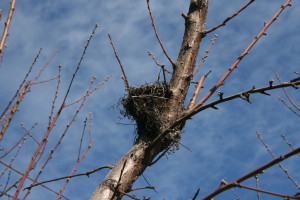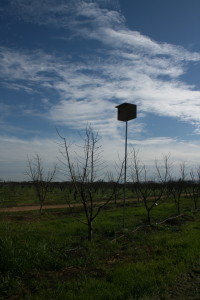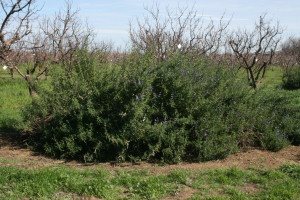
This time of year it is easy to see old bird nests among the bare branches
We recently had the chance to talk with Kyle Marsh, partner biologist at Blue
Point Conservation Science about a bird survey he did on Frog Hollow Farm in December. Kyle’s work normally takes him to rangelands in the North Bay but Farmer Al and Rachel, our resident soil health expert, asked him to come to Frog Hollow Farm to assess the health of our overall ecosystem. Kyle’s bird count helps shed light on the overall health of the farm’s environment and will allow us to make educated choices about how to best care for our land.
 For the survey, Kyle walked the property for about 2 hours and recorded every bird he heard and saw during that time. Since he is used to surveying on more open and wild ranch land he wasn’t sure what to expect but he was pleasantly surprised by the quantity (364 individuals) and diversity (29 species) of birds found in our orchards. And, while the quantity of birds is important, what is most significant was the wide variety of species he encountered. One flock of the dreaded European Starling, an aggressive invasive species would not be a sign of a balanced habitat.
For the survey, Kyle walked the property for about 2 hours and recorded every bird he heard and saw during that time. Since he is used to surveying on more open and wild ranch land he wasn’t sure what to expect but he was pleasantly surprised by the quantity (364 individuals) and diversity (29 species) of birds found in our orchards. And, while the quantity of birds is important, what is most significant was the wide variety of species he encountered. One flock of the dreaded European Starling, an aggressive invasive species would not be a sign of a balanced habitat.
Kyle spotted evidence of large raptors like hawks and owls hunt tree-root-eating gophers as well as smaller birds like Black Phoebes and Bushtits who eat insects. Kyle even saw 3 Loggerhead Shrikes, a species who sometimes hunt by pinning their lizard prey on barbed wire! It is a good sign that our land can support this bustling population of birds.

These native sage bushes have dozens of birds twittering away in them.
Different birds need different habitats and our citrus trees, grapevines, stonefruit trees, owl boxes, native plants and farm buildings provide a diversity of
habitat good for supporting a wide range of birds throughout the year. Frog Hollow Farm has something for everybody!
So why do we want birds to attract birds to Frog Hollow Farm?Just like having beneficial bacteria and fungi in our soil to keep pathogens in check, having lots of the right kind of birds in our orchards helps manage the population of other bigger pests.
Now that we have this dataset as a starting point, Kyle will return later this year to do another survey and compare his findings. One thing he will look for his summer is signs of birds raising young. Luckily, the evidence you can see in the photo above looks promising!

 Follow
Follow
